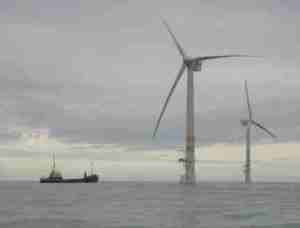From an editorial in The Journal Times (Racine):
With oil at record prices along with gasoline at the pump, Wisconsin has again awoken to the potential of the free energy flowing in the winds off the shore of Lake Michigan.
We say again because there was a feasibility study in 1992 to assess the potential of wind power from turbines sited just a few miles offshore on the Racine Reef. Last week’s news reports discussed the possibilities which three developers see in generating power from the lake winds with a few hundred turbines placed some miles off the coast. They have not applied to the state for any permits; these are mere concepts, not finished designs. We hope for quick action rather than concepts.
Although one potential developer said his project is on hold while awaiting a method of mooring turbines in deep water, in fact those solutions already exist. Last month a company called Blue H Technologies announced a lease of 40 square miles in the Atlantic Ocean 23 miles south of Martha’s Vineyard for the first deep water wind farm built on floating platforms. In the fall, officials in the United Kingdom unveiled two 5-megawatt turbines placed in 150 feet of water 15 miles off the coast of Scotland.
On the other side of the lake, Muskegon, Mich., is also looking at becoming a wind power capital. Consultants there have calculated that at an extreme, an area of 8,806square miles in the middle of the lake from Beaver Island to Chicago could hold 36,400 towers producing a combined 182,000 megawatts. For comparison, each of the two coal-fired generators being built in Oak Creek will produce 615 MW of power.
One issue for people on shore is the appearance of these modern turbines. These are giants reaching heights of 300 or so feet, and while we wouldn’t want to see such monsters standing on the Racine Reef, turbines 15 or 20 miles off the coast would be barely visible.
There are problems with wind power, no question, starting with the problem that the wind doesn’t blow all the time. But there are solutions to that — backup generating stations or storing excess power as compressed air, for example.
As we said, these ideas have been floating around since at least the early ’90s. It’s time for some action . . .

 12:29 PM
12:29 PM
 Unknown
Unknown



